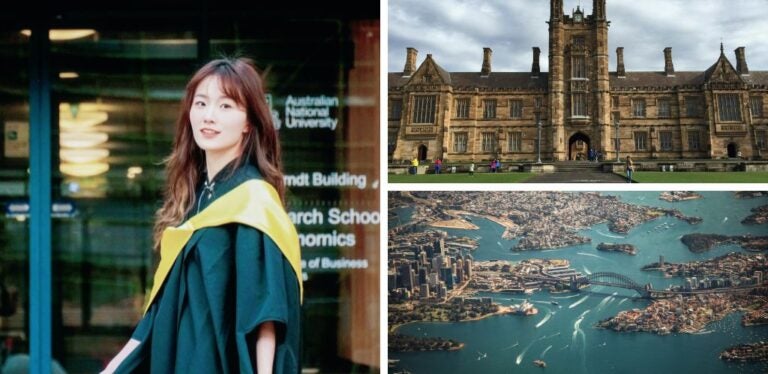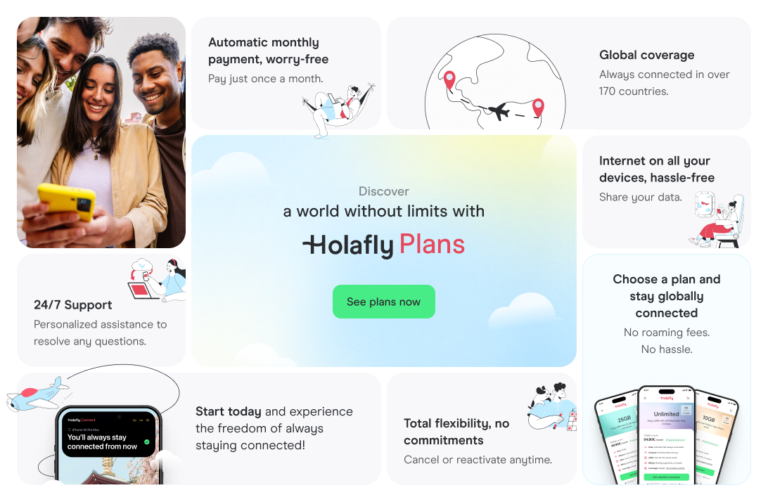Student visa for Australia: Requirements & process
Find out everything about the student visa for Australia. It covers the types of visas, their prices, and how to apply for them.
Australia is one of the top choices for international students. In 2023, over 600,000 people from around the world chose it as their destination to pursue higher education, improve their English, or attend technical colleges. With a wide range of academic programs and a rich cultural diversity that supports personal and academic growth, Australia is home to globally respected institutions like the Australian National University (ANU) and the University of Melbourne. So, what does it take to study in this land of opportunity? One of the first steps is applying for a student visa for Australia.
If you’ve looked into studying abroad, you probably already know it takes more than just booking a flight and showing up at your university. There’s paperwork to sort out before you can make the move. One of the most important steps is getting a residence permit so you can stay in the country legally. The good news? It’s easier than you might think. To help bring your study abroad plans to life, we’ve put together a full breakdown of the types of visas available, the requirements you’ll need to meet to get approved and the steps to follow when applying. Let’s get started on planning your academic adventure in Australia!
When do you need a visa to study in Australia?
If you’re thinking about living in Australia, you’ve probably come across comments about how tough it can be to get a residence permit. It’s a pretty competitive process, with priority given to candidates who match the country’s workforce and population needs. Unlike the U.S., Australia uses a points-based system to assess applicants.
You don’t need a permanent visa to study here, but if your course runs for more than three months, you will need a student visa for Australia. There are a few different types, and the one that’s right for you will depend on things like what you’re studying, where you’re enrolled, and what kind of benefits you want access to during your stay. If you’re aiming for a formal qualification there’s a specific visa category for that. Here’s how to figure out which one you’ll need:
- University courses and formal studies: If you’re planning to study for a bachelor’s, master’s, or PhD at a recognized institution, the Subclass 500 student visa is your go-to option. It’s the most common visa for international students and even lets you work while you study.
- International mobility or exchange programs: For those involved in academic agreements between universities, this visa is also valid.
- Technical or vocational training: If you’re taking practical training courses in fields like design, hospitality, or flying, you’ll still need to apply for the Subclass 500 visa, with the details depending on the institution you choose.
If your program lasts less than 12 weeks, a tourist visa might be enough. However, this will depend on the type of course and the rules set by the institution running it.
Types of visas for studying in Australia
Like you might expect, there’s a visa that covers most study programs, but it’s not the only option. If you’re coming to Australia for a language exchange or to complete an internship, you’ll need a different visa. Let’s break down the different student visas available so you can find the one that fits your plans.
Subclass 500 visa: The most common option for international students
It’s the most common visa. The Subclass 500 is designed for students enrolled in formal programs like university degrees, master’s, doctorates, intensive English courses, or technical training at accredited institutions. Besides studying, it lets you work up to 48 hours every two weeks, and full-time during school breaks.
This visa can be valid for up to five years and allows you to include eligible family members as dependents. It’s the key to accessing everything Australia has to offer, both academically and culturally.
Subclass 407 Visa: Practical training and education programs
This visa is made for those looking to take part in supervised training programs in Australia. It’s perfect for gaining hands-on experience in your professional field or developing skills in specific areas. Lasting up to two years, it’s designed to help students build their work skills in a real-world setting.
To apply for this visa, you’ll need sponsorship from an Australian organization that has approved your training program. It’s a great choice if you want to blend hands-on learning with real work experience in Australia.
Subclass 600 visitor visa: For short-term studies
The Subclass 600 is mainly a visitor visa, but it lets you take short courses up to three months long. It’s perfect if you want to join workshops, seminars, or short language programs without going through complicated paperwork.
The requirements are less strict than those for formal student visas, but you won’t be allowed to work while you’re there. It’s a handy option if you want a short educational experience while exploring the country.

Benefits of visas for studying in Australia
While many see simply getting one of these visas as a win, some come with extra perks. They also offer a chance to fully experience life in this fascinating country. Let’s take a look at the key benefits of each visa:
Subclass 500 visa: What are the benefits?
The Subclass 500 visa is designed for international students planning to study formal programs in Australia. It opens the door to universities, technical colleges, and language schools, while offering extra perks that enhance your time there.
- Stay during your study program: You’ll be able to live in Australia for the duration of your course, with the visa valid for up to five years. Plus, you’ll have enough time to finish your studies and make arrangements to leave the country if you don’t plan to stay longer.
- Ability to work while studying: This visa lets you work up to 48 hours every two weeks while classes are in session, and full-time during school breaks. It’s a great way to help cover your expenses and gain valuable work experience in an international setting.
- Traveling within and outside Australia: As long as your visa is valid, you’re free to leave and re-enter the country as many times as you need. Whether it’s for a vacation or to visit family, you’ve got the flexibility to come and go.
- Including your family as dependents: Your partner and children can join you in Australia, and in some cases, they may be allowed to work or study while you’re there.
Subclass 407 Visa: What are the advantages?
The Subclass 407 visa is meant for those looking to gain hands-on experience or develop their skills through supervised work. It’s perfect for anyone wanting professional training while immersing themselves in Australian culture.
- Specialized job training: You’ll have the chance to join training programs that boost your technical or professional skills in specific fields. This experience will give you an edge in the global job market.
- Access to professional networks: Working and training in Australia will allow you to meet employers and colleagues in your industry. It will open up opportunities for the future.
- Suitable duration for learning: You can stay for up to two years, which is enough time to gain practical experience and complete your training.
- Cultural and professional exploration: The visa lets you travel between different states in Australia, giving you the chance to combine your studies with a truly rewarding personal experience.
Subclass 600 Visa: What does it allow you to do in Australia?
While this visa is primarily for tourism in Australia, it’s also a great choice for those looking to take short courses. It offers flexibility for anyone wanting to get a feel for the country’s education system before committing to a longer program.
- Enroll in short-term programs: It lets you attend workshops, seminars, or language courses lasting up to three months. It’s ideal if you want to combine your visit with some learning.
- Travel around Australia: You can explore the country while completing your academic activities.
- No complex requirements: The application process for this visa is simpler.
Requirements for each type of student visa in Australia
Have you figured out which visa suits your study plans best? If so, it’s time to dive into what you’ll need to actually get one. Knowing the exact requirements will save you time and help you avoid mistakes that could hold up your application. Let’s take a look at what’s required for each visa.
Requirements to be eligible for the Subclass 500 visa
To apply for the Subclass 500 visa, you’ll need to meet several basic criteria that guarantee your eligibility as an international student:
- Enrollment at an approved educational institution: You’ll need to provide an official acceptance letter from the institution where you’re enrolling. This document will include the Confirmation of Enrolment (CoE), which is a mandatory requirement.
- Compulsory health insurance (OSHC): All applicants must have international student health insurance covering their entire stay in Australia.
- Financial solvency: You’ll need to show that you have enough funds to cover your tuition, living expenses, and travel costs. Currently, the requirement is set at 21,041 Australian dollars per year ($13,670).
- English language proficiency: Depending on the course, you may be asked to provide certificates such as IELTS, TOEFL, or PTE Academic to show your English skills.
- Medical history and background: You’ll need to undergo a medical exam approved by Australian authorities and provide a clean criminal background check.
Requirements for applying for a Subclass 407 visa
The Subclass 407 visa is focused on training programs and has specific eligibility criteria:
- Approved sponsorship: You need an Australian organization to act as your sponsor and manage your work or technical training.
- Clear training plan: You must submit a detailed training program outlining how it will develop your skills and experience.
- Financial solvency: Prove that you have the necessary funds to support yourself during your stay.
- Language requirements: Submit proof of English proficiency that meets the minimum requirements for your program.
- Medical insurance compliance: You’ll be required to complete a medical examination authorized by Australian officials and submit a clear criminal background certificate.
Requirements for applying for a Subclass 600 visa
Although the Subclass 600 is not a specific student visa, there are basic requirements you must meet if you plan to use it for short-term studies:
- Course duration: It cannot last longer than 12 weeks.
- Proof of enrollment: You need a letter confirming your enrollment in the workshop, seminar, or course you plan to take.
- Financial solvency: You must prove that you can cover both your travel expenses and your stay in Australia.
- Purpose of travel: It’s important to show that your stay is temporary and that you plan to return to your home country after finishing your studies.
- Travel insurance: Even though it’s not always required, it’s a good idea to get travel insurance for Australia.

How to apply for a visa to study in Australia?
Getting a student visa for Australia is not as hard as it seems. If you follow the right steps and have all your paperwork ready, you can get it done fairly quickly. Just be sure everything’s in order before you apply to avoid delays. Let’s take a look at the documents you’ll need and how to prepare for the application process.
Documents you must submit to obtain a Subclass 500 visa
If you plan to study a university, technical, or language course in Australia, you’ll need to submit the following documents:
- Online application form: You must complete this using the official platform of the Australian Department of Home Affairs (ImmiAccount).
- Valid passport: Your passport must be valid for the entire duration of your stay. It’s crucial that it’s up to date since all your application details will be linked to this document.
- Confirmation of Enrolment (CoE): Issued by the school or university where you’ll be studying, it should include details like the length of the course and any payments you’ve made.
- OSHC medical insurance: You’ll need an insurance policy that covers you for your entire stay in Australia. You can get this through your university or choose an approved provider that suits you.
- Proof of financial solvency: Bank statements, sponsorship letters, or scholarship documents that prove you can cover your tuition, housing, and living expenses.
- English language tests: Valid results from exams such as IELTS, TOEFL, or PTE Academic.
- Criminal record certificate: Issued by your country of origin and translated into English if necessary.
- Recent photograph: Passport size, with a white background, and meeting the requirements indicated on the application platform.
Documents you must submit to obtain a Subclass 407 visa
If you plan to attend training or education programs in Australia, you’ll need to submit the following documents:
- Online application form: Available on the official platform of the Australian Department of Home Affairs (ImmiAccount).
- Valid passport: Make sure it’s valid for the entire length of your stay. The information on your application needs to match what’s on this document.
- Sponsorship letter: Issued by the Australian organization sponsoring your training program, this document should outline the training plan and how it relates to your professional development.
- OSHC medical insurance: Mandatory coverage that ensures you have access to healthcare services while in Australia. You can obtain it through government-approved providers.
- Proof of financial solvency: Bank statements, financial support letters, or scholarship documents that show you have enough funds to cover your living and transportation costs.
- English language tests: Recent results from exams such as IELTS, TOEFL, or PTE Academic, depending on the level required by your training program.
- Criminal record certificate: Issued by your country of origin, with an official English translation if applicable.
- Recent photograph: Passport size, with a white background and in accordance with the requirements established by the Australian authorities.
Documents you must submit to obtain a Subclass 600 visa
Gather these documents to study short courses or language courses in Australia:
- Online application form: Complete it through the official ImmiAccount system.
- Valid passport: Make sure it is valid for the entire duration of your stay in Australia.
- Confirmation of registration: A letter or official document from the institution where you’ll be taking the course, outlining the program details and start and end dates.
- Proof of financial solvency: You’ll need to provide proof that you can support yourself while in Australia. This could be things like bank statements or a letter from a sponsor.
- Purpose of travel: A statement certifying that your main intention is temporary and that you will return to your country at the end of your visa.
- Travel insurance: It’s not required, but it’s a good idea to get health and travel insurance that covers emergencies while you’re in Australia.
- Recent photograph: Passport size, with a white background and following the quality standards established by the immigration authorities.
Interviews and questions for the student visa in Australia
Unlike some other countries, Australia usually doesn’t require student visa applicants to attend an interview. That said, you might be asked to meet with someone at the embassy or consulate if officials need to double-check some details or clarify parts of your application. But don’t worry, these interviews are generally straightforward. The questions typically focus on things like:
- Reason for your trip: Why you chose Australia and your course of study.
- Financial solvency: How you plan to cover your expenses and whether you have sponsors or scholarships.
- Future plans: What you will do once you finish your studies in Australia.
- Connection to your country of origin: Questions to confirm that your main intention is to study and that you will return once your visa expires.
The key to getting through this stage smoothly is having clear, confident answers and the right documents to back them up. Just be honest and make sure your responses match what you’ve already shared in your application.
Where can I apply for a visa to study in Australia?
By now, you probably have a solid sense of which visa you’ll need and what it takes to get it. So, how do you actually apply? The good news is that Australia has made the process pretty simple by moving most applications online. In general, you won’t need to visit a consulate or make extra calls.
- Online through ImmiAccount: The easiest and most recommended way to apply is online through Australia’s official Department of Home Affairs portal, ImmiAccount. There, you can set up an account, fill out your forms, upload all the necessary documents, and pay any fees (we’ll cover those in a bit). Plus, you can track your application status in real time.
- Australian embassies and consulates: Sometimes, if you need to hand in physical documents or do an interview, you might have to go to the closest Australian embassy or consulate. It’s especially useful if you have specific questions or need to take care of things that can’t be done online.
- Specialized consultancies or immigration agents: If you’d rather get professional help, you can hire a registered migration agent in Australia. These experts guide you through the application process and help make sure you meet all the requirements. While it’s not usually a cheap option, it can save you time and help avoid mistakes.
If you have any questions or need assistance along the way, don’t hesitate to reach out to the nearest Australian embassy or consulate. And don’t forget to get your Holafly eSIM so you can stay connected and receive their updates!
Important: If you are a frequent traveler and want to stay connected without worrying about expensive roaming or looking for a new SIM at every destination, Holafly’s subscription plans are for you. With a single eSIM, enjoy internet in more than 170 countries for a fixed price and no surprises on your bill. Travel without limits and connect easily and securely! 🚀🌍

How much does a visa to study in Australia cost?
Australia student visa fees can add up quickly, so it’s smart to plan for them early in your application process. Unfortunately, it’s one of the higher fees compared to other countries. While Spain’s student visa fees are around $70-90 and the UK charges about $460, the student visa australia cost goes beyond a thousand dollars. Let’s break down all the expenses you’ll need to cover:
- Subclass 500 visa application fee: The standard fee for this visa is 1,600 Australian dollars ($1,040). This covers the initial processing of your application and must be paid when you submit your form online. If you’re including dependents in your application, there will be an extra charge for each person.
- Compulsory health insurance (OSHC): To get the visa, you’ll need to have approved health insurance covering your entire stay. Costs vary depending on the provider and length of your course, but on average, you can expect to pay between 500 and 700 Australian dollars per year ($325-455) for one person.
- English language certificates and additional tests: If you need to prove your English skills with tests like IELTS or TOEFL, expect to pay around 300 to 400 Australian dollars ($195-260). You might also need medical exams, which typically cost between 200 and 400 Australian dollars ($130-260).
- Other administrative expenses: In some cases, you might face extra fees for things like police clearance certificates or official translations. These costs can vary, but you should budget around 200 to 400 Australian dollars ($130-260).
- Renewals and extensions: If you choose to extend your visa, you’ll need to pay an extra fee of around 650 Australian dollars ($425).
How long does it take to obtain a visa to study in Australia?
Like with all bureaucracy, it depends. Processing times can vary based on the time of year, how many applications are being handled, how quickly you complete your paperwork, and other factors. Here’s a rough estimate of the usual processing times:
- Initial processes: Once your chosen Australian institution accepts you, you’ll receive the Confirmation of Enrolment (CoE). This document usually takes 2 to 4 weeks to arrive. After that, you’ll need to fill out the online application form via ImmiAccount, which typically takes about 1 to 2 hours.
- Evaluation times: After you submit your application, Australia’s Department of Home Affairs will start reviewing it. On average, processing a Subclass 500 visa takes around 4 to 6 weeks. During peak times, like the start of the academic year, it can take up to 8 weeks.
You should expect the whole process to take between 6 and 10 weeks. If you need to undergo medical exams or provide extra documents, it could take even longer.
Lawyers to advise you on the visa application process for studying in Australia
If all this feels too complicated, there are options to make it easier. You can hire a professional agency that specializes in student visas to guide you through every step. We’ve put together a list of some well-known agencies to help you out:
Visa Australia Expert Lawyers, agency for applying for student visas in Australia
Visa Australia Expert Lawyers is a law firm specializing in Australian immigration. Their team provides personalized guidance to make sure you meet all the requirements and submit a flawless application.
- Location: 123 Queen Street, Melbourne, Victoria, Australia.
- Services: They offer full support for Subclass 500, 485, and 407 visas, including certified translation assistance, document review, and interview preparation if needed.
- Languages: English, Spanish, and Mandarin.
- Hours: Monday to Friday, 9:00 a.m. to 5:00 p.m.
- Fees: Their initial consultation starts at around 150 Australian dollars ($100), with tailored packages for full application support beginning at 900 Australian dollars ($590).
Immigration Solutions Lawyers
Based in Sydney, Immigration Solutions Lawyers is a well-known firm specializing in student visa cases. Their expertise in handling complex situations makes them a trusted choice for those seeking expert guidance.
- Location: 299 Elizabeth Street, Sydney, New South Wales, Australia.
- Services: Subclass 500 and 485 visa applications, advice on financial solvency requirements, and appeals in case of rejections.
- Languages: English, Spanish, Arabic, and Korean.
- Hours: Monday to Friday, 8:30 a.m. to 6:00 p.m.
- Fees: Initial consultations start at about 200 Australian dollars ($130), with full-service packages available from around 1,200 Australian dollars ($785).
True Blue Migration Services
This firm focuses on study and work visas. With over 15 years of experience, True Blue Migration Services is a great choice if you want tailored support for your situation.
- Location: 56 William Street, Perth, Western Australia.
- Services: They provide guidance with Subclass 407 and 485 visa applications, help coordinate medical exams, and assist in preparing financial documents.
- Languages: English and Spanish.
- Hours: Monday to Friday, 9:00 a.m. to 4:30 p.m.
- Fees: Initial consultations start at 250 Australian dollars ($165), with full-service packages available from 1,500 Australian dollars ($980).
Australia Migration Agency
Australia Migration Agency focuses on providing affordable and efficient support for international students. Their team of registered agents is ready to assist you with every step of your visa application.
- Location: 45 George Street, Brisbane, Queensland, Australia.
- Services: Subclass 500 and 485 visa management and renewals, document translation, and OSHC health insurance consultations.
- Languages: English, Spanish, Portuguese, and French.
- Hours: Monday to Friday, 9:00 a.m. to 5:00 p.m.
- Fees: Initial consultations begin at 120 Australian dollars ($80), with comprehensive packages starting from 800 Australian dollars ($525).
Frequently asked questions about visas for studying in Australia
As soon as you get your Confirmation of Enrolment (CoE) from your education provider, you should apply for your student visa. This document is key to starting the process. Since visa approval usually takes around 4 to 6 weeks, it’s smart to start your application a couple of months before your course begins to avoid any last-minute issues.
Yes, with the Subclass 500 visa, you can work up to 48 hours every two weeks while classes are in session. During your holidays, you’re allowed to work full-time. This gives you a great chance to earn extra money to help with expenses and gain valuable work experience abroad.
In many cases, yes. If you need extra time to finish your studies or plan to enroll in another course, you can extend your student visa by applying again. Just make sure to start the process before your current visa expires, because staying in the country without a valid visa can cause problems for future applications.
Not directly. However, the academic and work experience you gain in Australia can boost your chances of qualifying for other visas, like the Subclass 485 (Temporary Graduate Visa) or skilled permanent residency visas. These options are open to those who meet certain criteria related to skills, work experience, and education.
If your visa application is denied, you’ll receive a formal explanation outlining why. Sometimes, you can appeal the decision with the Administrative Appeals Tribunal (AAT), or fix the issues and reapply. Having a registered migration agent guide you can be a big help during this process.
Yes, every international student must have an approved health insurance called Overseas Student Health Cover (OSHC). This insurance is mandatory for your entire stay in Australia and covers essential services like doctor visits, hospital stays, and medication. You can get it through your university or approved providers.
If your Subclass 500 visa comes with a post-study work period, you’ll typically be allowed to stay in Australia for 2 to 3 months after finishing your course. If you want to extend your stay to work or keep studying, you’ll need to apply for a Subclass 485 visa or look into other visa options that fit your plans.
When you work in Australia as a student, the government requires you to pay taxes on your earnings. You’ll receive a Tax File Number (TFN) when you start your job. If you want to understand how to manage your tax duties while living in Australia, take a look at our guide on taxes for foreigners.





 Language
Language 


















 No results found
No results found







